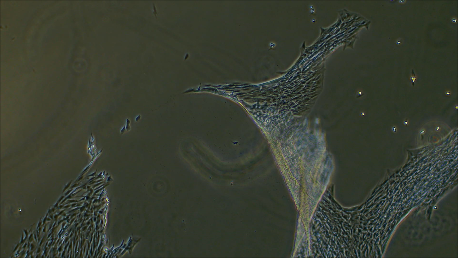Introduction: Construction of human tissues in vitro is becoming more essential for an alteration of animal experiment, screening of medicine, and regeneration of organs as studies of cells including induced pluripotent stem (iPS) cells and embryonic stem (ES) cells have been developed. To construct tissues, it is one of the most important issues about how to collect cells rapidly with the minimum damage without trypsinization. To solve this problem, a thermoresponsive polymer is used for cells deadhesion. This polymer changes their hydrophobic/hydrophilic properties responding to the temperature shifts. For example, poly(N-isopropylacrylamid) (PNIPAAm) -grafted dishes have been used for cell culture especially to construct cell sheets[1]. Cells can adhere to the PNIPAAm surface at above 32℃ and be detached from the surface at below 32℃. However, PNIPAAm-grafted dishes need 10-30 minutes for detaching cell sheets and some kinds of cells cannot adhere on it. Therefore, the tissue deadhesion system that can rapidly detach cells and can apply to various cells has been eagerly required. In this study, we developed unique thermoresponsive polymer derived from polysaccharide for novel method for rapid collection of cells and constructing human tissues.
Materials and Methods: We used cell culture dish coated with the polymer derived from polysaccharide by spincoating and dipcoating. The polymer-coated dish has thermoresponsive property based on the reversible hydropholic/hydrophilic phase-change. Subsequently, polymer surface of some dishes was coated with ECM matrix. The NHDF(Normal Human Dermal Fibroblasts) cells were cultured with D-MEM media contains 10% FBS and 1% antibiotics for 3 days (37℃, 5% CO2).
Results and Discussion: NHDF cells were able to adhere and grow on the polymer surface whose thickness was lower than some extent. Tissues were able to be detached from the surface by gently pipetting at 4℃ without trypsinization. This detachment occured not only on the ECM-coated surface but on the non-coated one. This detachment takes shorter time than other thermoresponsive polymers such as PNIPAAm.
Conclusion: We successfully confirmed that novel thermosresponsive polymer could collect cells more rapidly than before. Our results demonstrate that this novel method should be useful for cell culture and also for construction of 3D tissues.

Figure.1. Detached NHDF cells cultured on thermoresponsive polymer-coated surface.
References:
[1] Yamada N., Okano T., Sakai H., et.al. Chem.Rapid Commun, 1990,11,571